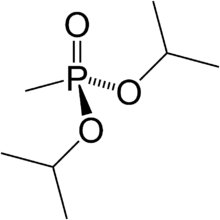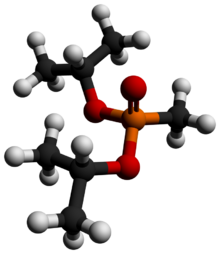Chemistry:Diisopropyl methylphosphonate
From HandWiki

| |

| |
| Names | |
|---|---|
| Preferred IUPAC name
Di(propan-2-yl) methylphosphonate | |
| Other names
2-(Methyl-propan-2-yloxyphosphoryl)oxypropane
| |
| Identifiers | |
3D model (JSmol)
|
|
| Abbreviations | DIMP |
| ChEBI | |
| ChemSpider | |
PubChem CID
|
|
| UNII | |
| |
| |
| Properties | |
| C7H17O3P | |
| Molar mass | 180.184 g·mol−1 |
| Density | 0.976 g/mL |
| Boiling point | 215 °C (419 °F; 488 K) |
| Hazards | |
| Flash point | 98 °C (208 °F; 371 K) |
Except where otherwise noted, data are given for materials in their standard state (at 25 °C [77 °F], 100 kPa). | |
| Infobox references | |
Diisopropyl methylphosphonate (DIMP), also known as diisopropyl methane-phosphonate and phosphonic acid and methyl-bis-(1-methylethyl)ester, is a chemical by-product in the production of sarin gas.[1]
DIMP is a colorless liquid that has been shown to affect the hematological (blood forming) system in animals.[2] Its chemical formula is C7H17O3P.[3]
History
DIMP is a chemical by-product resulted from the manufacture of sarin (GB).[4]
Use
No commercial uses of DIMP are known to exist.[5]
Occurrences
DIMP is not known to occur naturally in the environment.[citation needed]
Productions
Synthesis
DIMP can be prepared by a gradual addition of triisopropyl phosphite with methyl iodide, utilizing distillation technique.
References
- ↑ "ATSDR - Toxic Substances - Diisopropyl Methylphosphonate (DIMP)". Atsdr.cdc.gov. 2011-03-03. https://wwwn.cdc.gov/TSP/index.aspx?toxid=203.
- ↑ "tf119" (PDF). http://www.atsdr.cdc.gov/toxfaqs/tfacts119.pdf.
- ↑ "Center of Chemicals". Chemicals.pl. http://www.chemicals.pl/.
- ↑ ATSDR – Toxic Substances – Diisopropyl Methylphosphonate (DIMP)
- ↑ [1] [bare URL PDF]
 |

